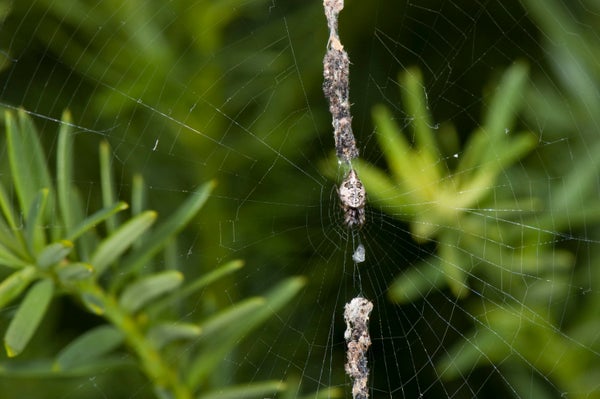Darrell Moore is typically a honeybee guy. He’s been studying them for 40 years. But a few years ago, his colleague Thomas Jones asked for his opinion about some weird spider behavior.
Jones studies social behavior in the orb weaver spiders that his undergraduate students collect near their East Tennessee State University campus. Spiders are both predators and prey. Their aggression and passivity fluctuate depending on hormone levels that determine whether they are more likely to eat or be eaten. Jones noticed the spiders’ behavior—alternating between boldness and timidity—were also tightly linked to the time of day. He asked Moore, a circadian rhythm expert, to look at the spiders’ internal clocks that regulate their daily activities.
Circadian rhythms dictate many of the body’s most fundamental processes, including eating, sleeping and hormone secretion. Every organism previously studied—from humans to hamsters to fruit flies to bacteria—more or less follow the 24-hour day/night cycle. When the scientists measured the internal clocks of trashline orb weavers, however, they saw something extraordinary: The spiders ran on an 18.5-hour day, the shortest natural circadian cycle ever observed. “This was a total surprise. We didn’t expect to see anything like this,” Moore said during a presentation at the annual Society for Neuroscience conference in Washington, D.C., last week. “Theoretically, [these spiders] should not exist.” The spiders are comparable to mutant animals scientists create in the lab to study circadian rhythms this short. He says those animals, however, “have many difficulties and struggle to exist.”
On supporting science journalism
If you're enjoying this article, consider supporting our award-winning journalism by subscribing. By purchasing a subscription you are helping to ensure the future of impactful stories about the discoveries and ideas shaping our world today.
To measure the clocks, the scientists put the spiders in test tubes, kept them in the dark and shined infrared beams on them. Whenever the arthropods moved, they triggered the beams to record their activity. Most of the time the spiders stayed motionless as if they were hanging out in their webs, but for a couple hours every day they exhibited bursts of activity.
Without cues from light and heat to mark time passing, the spiders rested and moved in 18.5-hour cycles. If the researchers exposed the spiders to bursts of light, however, they would reset their clocks by six hours the next day. For most of the animal world, that’s like having a six-hour jet lag every day, but the spiders instantly adjusted without any problems.

Darrell Moore. Credit: Richard Bradley
This process of shifting an internal clock to match external cues is called entrainment, and no other organism (that we know of) is able to shift its clock by more than an hour or two. Moore says that when he tells other circadian rhythm researchers about the finding, “Their first response is, ‘What?’ The second response is, ‘Oh shit!’”
Having an internal clock that deviates from the natural 24-hour cycle is generally considered disadvantageous. Animals with gene mutations that significantly alter their circadian rhythms have shorter life spans, and circadian rhythm sleep disorders in humans can have profoundly negative effects, including increased risk for obesity, depression, cardiovascular disease and cancer.
The trashline orb weavers appear to get by just fine. For most of the day they hang out in their webs camouflaged within a vertical thread made out of trash (poop, leftover pieces of prey or other stray debris). There, they wait for an unsuspecting insect to get caught, while remaining hidden from other predators themselves. For a few hours every night, the spiders go to work building and repairing their webs. Most orb weaver species rebuild their webs just after sunrise. But thanks to their faster clocks, the trashliners get an early start, becoming most active while it’s still dark out. Moore and Jones say this predawn engineering feat could help the spiders avoid predators, providing perhaps an evolutionary explanation for the trashliners’ faster internal clocks.
Since their initial discovery the scientists have tested 20 species of spiders and identified seven others that run on either a very short clock (17, 18 and 19 hours), a very long clock (27, 28 and 29 hours) or no clock at all. “The thrill of discovery is what’s science is about, and this has been fertile territory,” Jones says. “Every time we look at a new species there’s something weird about it.”
The scientists are now testing clock genes to figure out how the spiders’ biological clocks work. They also suggest other species’ circadian rhythms should be tested. Sigrid Veasey, a sleep researcher at the University of Pennsylvania who was not part of the research, agrees. “It’s a wake-up call that we as scientists should be looking at creatures in the wild,” she says. “Looking at lab-entrained species is not sufficient to answer some of these larger questions.”
